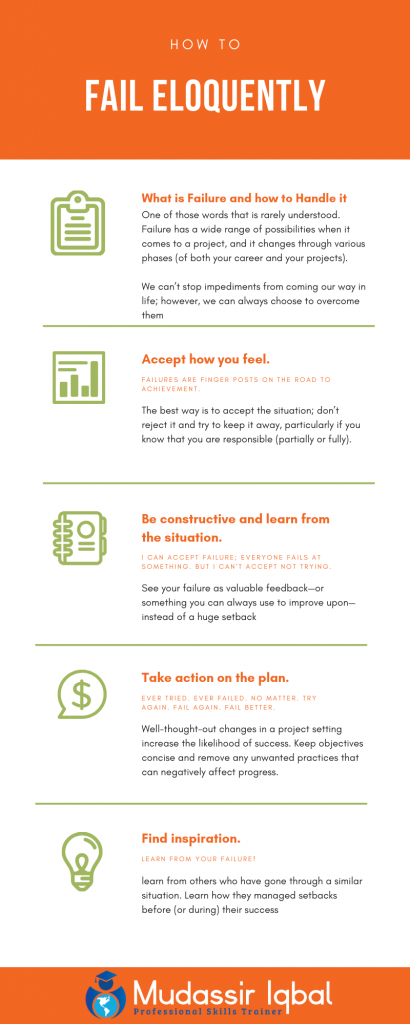How to fail Eloquently
Change is inevitable. The same can be said for failure, which is part and parcel of professional life. Failure is tough to handle and tougher to talk about, but an unfortunate reality. “Learn from your failure!” is what we usually hear, but it’s easier said than done. But take my word for it—it will come with a little effort and practice. Here, I want to discuss not why projects fail, but how we as project managers should react in the face of failure.
 Defining Failure
Defining Failure
“Failure” is one of those words that is rarely understood. It means different things to different people. My understanding keeps changing. Today when I fail, I clinically analyze the level of failure using a variety of parameters that I learned during my career on different jobs. Failure has a wide range of possibilities when it comes to a project, and it changes through various phases (of both your career and your projects).

It reminds me of when I complained to my first manager that our client hadn’t shelved the best possible product that we built for them. It was a complete failure for me because I couldn’t gauge what was expected. His answer was interesting: “Mudassir, they paid in full.” Again, failure is different for different people.
Handling Failure
We can’t stop impediments from coming our way in life; however, we can always choose to overcome them. They may block your visualization for a while, but you can always figure out new approaches and outlooks. As you get more proficient, you will eventually see things (and yourself) positively—even in the toughest situations.
Project failure occurs for various reasons, whether stakeholders are changing their objectives, budgets have started disappearing or the project management approach is not up to the mark. Here are some ways to handle it…
1. Accept how you feel.
Many project management enterprises fail at different phases of their life cycle. If you have failed (or are about to fail), it will probably hurt (a little or a lot). That’s normal! Do not try to distract yourself or make the world accountable for the whole situation, particularly if you know that you are responsible (partially or fully).
The best way is to accept the situation; don’t reject it and try to keep it away. Acceptance will make it less painful in the long run. If you deny how you really feel, these emotions will pop up sooner or later at an inopportune time and make you feel pessimistic, angry or sad.
“Failures are finger posts on the road to achievement.”
— C. S. Lewis
2. Be constructive and learn from the situation.
See your failure as valuable feedback—or something you can always use to improve upon—instead of a huge setback. A major portion of this task will involve you reviewing and detailing changes in the failed project management process.
One of the simplest and most helpful ways is to ask yourself constructive questions, not ones that will prompt a negative mindset. For instance, what one important thing have you learned from your failure? What one thing can you do differently next time? How can you adjust and do better next time?
Take some time out for these questions and be honest with your answers. There is no hurry, as some of the answers might take a few days. The important thing is to think about the situation from another perspective and be constructive rather than stuck in apathy or negativity. You need to go beyond surface-level answers to figure out why your project is failing (or has failed).
“I can accept failure; everyone fails at something. But I can’t accept not trying.”
— Michael Jordan
3. Take action on the plan.
The plan you have come up with is just a start; you don’t need to make it perfect. It can combat the fear of failing again (and the difficulty in even moving afterwards). Divide your plan into small steps. If you find it hard to start, then simply aim for a small step of action. Moving will ultimately keep you at peace.
Well-thought-out changes in a project setting increase the likelihood of success. Keep objectives concise and remove any unwanted practices that can negatively affect progress.
“Ever tried. Ever failed. No matter. Try again. Fail again. Fail better.”
— Samuel Beckett

4. Find inspiration.
A discussion with someone can be very helpful; you can learn from others who have gone through a similar situation. Learn how they managed setbacks before (or during) their success. You can do this in personal conversations or through websites, online forums and books. Tap into their motivation by listening to a great podcast or audiobook. This doesn’t have to exactly match your particular challenge, as it can still shift your mood and outlook back toward optimism.
Three important factors in a successful failure (yes, a successful failure!) are:
-
-
- Communication
- Engaging with stakeholders—even when they are at their most resistant state
- Conducting post-mortems
-
Finally, it’s important that any failure doesn’t stop you from moving forward. Many of these things I’m saying may seem easier said than done, but we need to practice. Project management requires an attitude; it is something you may learn over a period of time with the right coaching. As I write this, some of my failed projects (both professional and personal) are popping up in my brain, one after another—and I feel good knowing that nothing stopped me from moving forward and creating more memories (some good and some bad).


One thought to “How to Fail Eloquently”
Pingback: Project Procurement Management - PMP/CAPM (PMBOK 6 - ECO 2019) by Mudassir Iqbal, PMP